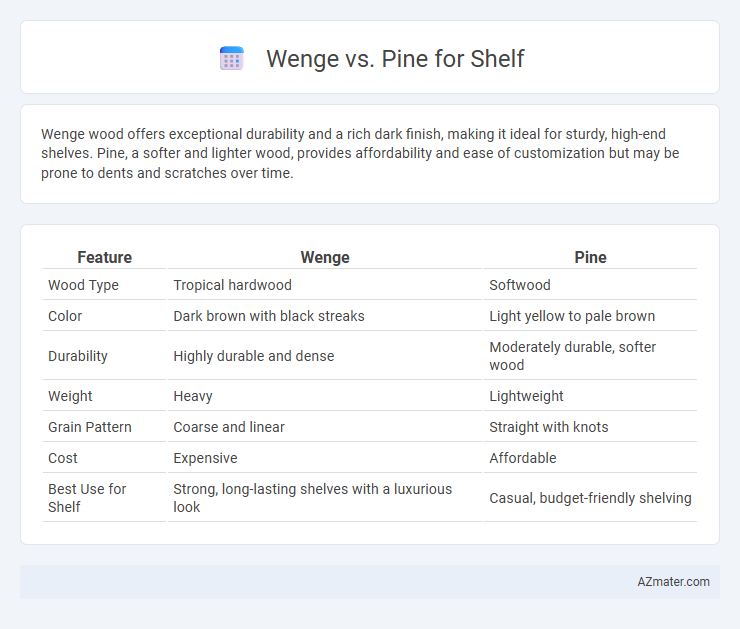Wenge wood offers exceptional durability and a rich dark finish, making it ideal for sturdy, high-end shelves. Pine, a softer and lighter wood, provides affordability and ease of customization but may be prone to dents and scratches over time.
Table of Comparison
| Feature | Wenge | Pine |
|---|---|---|
| Wood Type | Tropical hardwood | Softwood |
| Color | Dark brown with black streaks | Light yellow to pale brown |
| Durability | Highly durable and dense | Moderately durable, softer wood |
| Weight | Heavy | Lightweight |
| Grain Pattern | Coarse and linear | Straight with knots |
| Cost | Expensive | Affordable |
| Best Use for Shelf | Strong, long-lasting shelves with a luxurious look | Casual, budget-friendly shelving |
Introduction to Wenge and Pine Woods
Wenge wood, originating from Central Africa, is renowned for its dark brown to almost black color and dense, durable structure, making it ideal for high-end shelving that requires strength and longevity. Pine, a softwood commonly sourced from North America and Europe, features a light color with prominent grain patterns and is valued for its affordability and ease of workability in shelf construction. Both woods offer distinct aesthetic and functional qualities, with Wenge providing a luxurious, robust finish and Pine delivering a lightweight, cost-effective solution.
Wenge vs Pine: Visual Appearance
Wenge wood features a rich, dark brown color with distinct black streaks, creating a luxurious and sophisticated look for shelves, while pine offers a lighter, creamy tone with noticeable knots and a more rustic, natural appearance. The dense grain pattern of wenge provides a smooth, refined texture that enhances modern or high-end interiors, contrasting with the softer, more porous texture of pine that complements casual or country-style decor. Wenge's deep hues resist visible wear and stains better than pine's lighter surface, making it a preferred choice for both durability and aesthetic impact in shelving.
Strength and Durability Comparison
Wenge wood is known for its exceptional hardness and resistance to wear, making it highly durable for shelving that must support heavy items. In contrast, pine is a softer wood that is more prone to dents and scratches, reducing its overall strength and longevity under weight stress. For shelves requiring maximum durability and long-term strength, wenge is the superior choice compared to pine, which is better suited for lighter, decorative use.
Workability and Ease of Installation
Wenge wood offers high density and hardness, making it durable but more challenging to cut and drill compared to pine. Pine's softer texture allows for easier saw cuts, sanding, and fastening, which accelerates installation and reduces labor effort. Workability of pine makes it ideal for DIY shelving projects, while wenge requires specialized tools and experience for clean, precise assembly.
Cost Differences: Wenge vs Pine
Wenge wood is significantly more expensive than pine due to its rarity and dense hardwood properties, typically costing three to five times more per board foot. Pine is a cost-effective softwood that offers affordability and ease of use, making it a popular choice for budget-conscious shelf projects. The price gap influences material selection, balancing Wenge's durability and rich dark appearance against Pine's economic advantage and lighter color.
Shelving Applications: Best Uses for Each Wood
Wenge wood, with its dense, durable, and moisture-resistant properties, excels in heavy-duty shelving applications such as industrial or high-traffic areas where strength and longevity are crucial. Pine, being lighter, more affordable, and easier to work with, suits decorative shelving in residential spaces, offering flexibility for customization and a warm, rustic appearance. Choosing between Wenge and Pine for shelves depends on balancing the need for robustness against budget and aesthetic preferences.
Maintenance and Longevity
Wenge offers superior durability and longevity compared to pine, resisting dents and scratches due to its dense hardwood structure, making it ideal for long-term shelf use. Pine requires more frequent maintenance, such as sanding and refinishing, because it is softer and prone to dents, scratches, and discoloration over time. Regular sealing or varnishing can extend the lifespan of pine shelves, but wenge maintains its structural integrity and appearance with minimal upkeep.
Environmental Impact and Sustainability
Wenge wood is a dense hardwood sourced primarily from Central Africa, often criticized for unsustainable harvesting practices leading to deforestation and habitat loss, whereas pine is a faster-growing softwood commonly cultivated in managed forests with renewable practices. Pine's rapid growth rate enables quicker carbon sequestration and replenishment, making it a more environmentally friendly choice for shelving. Selecting FSC-certified pine products further ensures responsible forest management and reduces negative environmental impacts compared to the often unregulated sourcing of wenge.
Customization Options and Finishing
Wenge offers a rich, dark finish that highlights its dense grain, providing a luxurious and elegant aesthetic ideal for customizable stains and oil finishes that enhance durability. Pine's lighter, softer wood grain allows for extensive customization with paints, stains, and distressed finishes, making it versatile for various styles from rustic to modern. Both woods can be finished with clear coats for protection, but Wenge's harder surface typically requires professional handling to achieve a smooth finish, whereas Pine is easier to sand and refinish at home.
Final Verdict: Which Wood is Better for Shelving?
Wenge offers superior durability and a rich, dark finish that resists scratches and wear, making it ideal for high-end shelving projects requiring longevity and aesthetic appeal. Pine, being softer and lighter, is more affordable and easier to work with but may dent or scratch more easily over time, suitable for budget-conscious or decorative shelving. For functional, long-lasting shelves, Wenge is the better choice due to its strength and resistance to damage.

Infographic: Wenge vs Pine for Shelf
 azmater.com
azmater.com